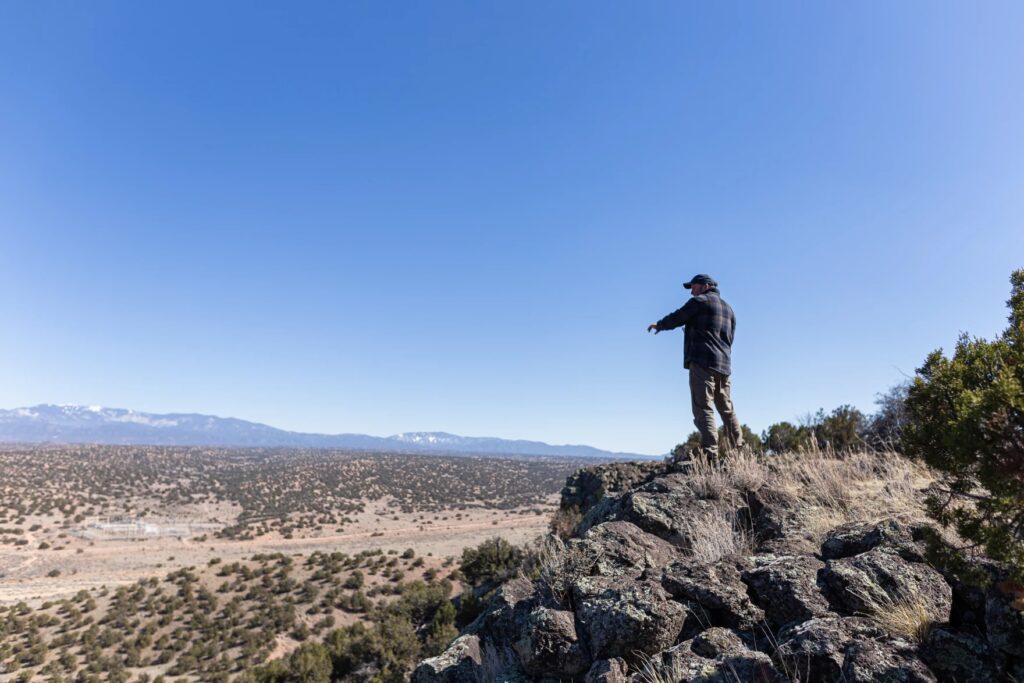New Mexico Wild’s Garrett VeneKlasen points at the Norton Substation, which provides a portion of LANL’s power. An electric hum can be heard from the top of the Caja del Rio plateau. (Photo by Bryce Dix / KUNM News)
The U.S. Forest Service has now put their seal of approval on a controversial transmission project spanning portions of the sacred and historically significant Caja Del Rio plateau.
Tuesday’s draft decision comes as tribes call for a comprehensive study of the power line’s cultural impacts.
Los Alamos National Laboratory wants to construct a 115kV power line that would span parts of White Rock Canyon and the Caja plateau in the name of sufficiently powering “national security.” It would be the third such line in the area.
Specifically, LANL said the energy boost will power a new supercomputer for nuclear isotopes research and advanced climate modeling.
The Forest Service found that the project has “no significant impact” on the area’s environmental and cultural resources, according to the report. The agency’s findings have been delayed several times – leaving advocates, Native communities, and residents alike waiting with bated breath for almost a year.
“It feels like we were completely ignored,” said attorney Jim James, who represents the nearby Pueblo of Tesuque. “Our interests, our beliefs, our value systems, they don’t count.”
James said tribes in the area – which also include San Ildefonso and Kewa Pueblos – received another long-awaited cultural impact report from the National Nuclear Security Administration in late May. But he argued it was mostly a compilation of old academic research by non-Natives. Pueblo leadership said they felt misled, expecting a modern, full-blown archaeological survey. That sparked a push for a comprehensive, tribal-led cultural study to be completed before construction begins.
When contacted for details on the report, an NNSA spokesperson told KUNM it was not publicly available because it contains “site-specific information that is not disclosable to the public,” protected by the National Historic Preservation Act.
Advocates are also not happy with the Forest Service’s environmental analysis of the project.
New Mexico Wild’s Garrett VeneKlasen, a member of the Caja del Rio Coalition, which opposes the project, said there needs to be a deeper, critical look at how the line will harm the area’s wildlife.
“I hate to say it, but we got to put a leash on this dog,” VeneKlasen said.
GET THE MORNING HEADLINES DELIVERED TO YOUR INBOX
SUPPORT NEWS YOU TRUST.
Coalition members want the federal government to conduct a more involved “environmental impact statement.”
Tuesday’s USFS report does not mark the end of the legal process. The Bureau of Land Management and the National Nuclear Security Administration also need to weigh-in. But, the new draft decision is significant because the recently amended Santa Fe National Forest Management Plan will need to be revised specifically for the utility corridor. Both VeneKlasen and James expect the decision to be finalized.
The publication of the draft decision opens up a 45-day objection period until Saturday, Oct. 26. To be eligible, stakeholders must have participated in earlier stages of the process.
If the USFS finalizes the proposal, members of the Caja Del Rio Coalition say they plan to protest outside of the Santa Fe National Forest regional office.

